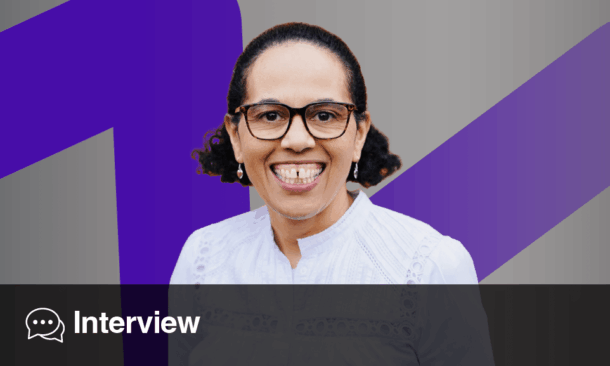Jennifer Turgiss, Vice President, Behaviour Science & Analytics, Johnson & Johnson Health and Wellness Solutions
![]()
Interviewed by Louise Rogers | @EMG_Louise_
![]()
Jennifer Turgiss leads the behaviour science and analytics teams at Johnson & Johnson (J&J), applying her expertise in behavioural and social science to develop digital health behaviour change interventions. We spoke to Jennifer at this year’s eyeforpharma, Barcelona on her long-standing career in the Health and Wellness industry and scaling bespoke patient behaviour change programmes.
Q: What is one of your proudest achievements during your career in the wellness and life-sciences industry?
A: I spent 14 years of my career with Virgin Group and, during this time, the company had a group of health and wellness centres in South Africa that were going into receivership. At the time, Virgin was one of the largest employers in South Africa; a lot of people were going to lose their jobs and a lot of customers were going to lose access to places to be physically active. I was asked to assist with the business turnaround and, within 12 months of Virgin flying a group of team managers and myself into South Africa, we had successfully turned the health and wellness centres into a successful business. It was a fantastic leadership opportunity; I had never worked with the team that I was managing, and I had to build their trust and their confidence in me that I was there to help their business. Along the way, I also met Nelson Mandela, which was absolutely awesome. This opportunity was definitely one of the highlights of my career.
Q: What does the term ‘wellness’ mean to you?
A: Wellness and wellbeing are often used interchangeably. For me, they are different things. Wellbeing is a personal perception about our lives; it’s about where we are, how we are in our lives against where we think, and how we think we should be at that given time. This has a big effect on our mental and emotional state, and this is one of the critical factors in driving motivation to change our habits, whether adding new habits or stopping existing ones. Then, from a programmatic standpoint, wellness is how we manage our lifestyle; what do we do to make sure we are sleeping, exercising, eating better, etc. There is a lot we can tackle from a programmatic point of view to improve the wellbeing of an individual.
Q: What are the foundations to creating a bespoke patient programme that is then scalable?
A: This is where technology comes in and where we can build an infrastructure that is repeatable in a configurable way. We can put different options and exercises together to fit the end user of the tool. So, rather than building a number of different products, we are building a technology that adapts and becomes relevant for a number of different users who are engaging with it. Think of it as the direction technology is heading; it’s essentially a GPS for your health. The user has a journey and is heading in a certain direction. Maybe the journey is to quit smoking or to manage stress levels. Along the way, instead of taking a left, you take a right, so then the system will need to readjust to the changed course and will need to figure out how to get you back on track, relative to where your starting point was.
Q: Is there a health solution that the pharma industry is not taking full advantage of yet, to prevent, manage, and treat disease?
A: The challenges the industry has with tackling prevention are with the current business model. Until we can figure out how to fund prevention projects, it will just remain a good idea that is never fully executed, so it must work as a business plan. The consumer business models of the world are demonstrating how we may be able to tackle this and are doing a much better job than we are in pharma. For example, consumers are directly spending their money on their own health and their own initiatives. Now the industry needs to figure out the best way to transform from our current business mode to include the value of prevention.
Q: Could you discuss an initiative you have been a part of at J&J to bring better, more sustainable health solutions to low-income markets?
A: Mobile applications and technology are great because they allow all users to participate. At J&J, we work alongside a few hospitals in getting patients prepared for surgery. This application is provided to patients at no cost and the hospitals have found a value model that works. The system works with individuals based upon their obstacles and resources that are available to them. Regarding low-income and developing countries, J&J has had a lot of success with mobile technologies, particularly with text-based communication in delivering interventions. One of our projects, ‘MAMA’ (Mobile Alliance for Maternal Action), was essential to delivering health information to new and expecting mothers. It’s a text-based solution, delivered to women on their own personal device. It works because there is not a lot of technology infrastructure needed. While smart phones may not have shown up yet everywhere, cell phones have, and they are a great way to reach people.
Q: What personality traits and values do you have, and think are essential for an individual in a health and wellness leadership position?
A: I definitely have an entrepreneurial spirit; I will always be looking to find a new way to solve a problem. If a problem still exists, then it’s because we haven’t found a way to solve it. So, in my role there is a need for creativity, continual problem solving, and a doggedness of what we are trying to accomplish and why. Having a sense of purpose is so important, and this is one of the best traits of J&J, our Credo: constantly asking ourselves and employees why we are doing what we are doing. Our Credo was instated >75 years ago because J&J realised there was a need to keep meaning behind our actions. As leaders, we all need a North Star: to keep us true, on track, inspired, and working tirelessly towards what we want to achieve. In my opinion, pharma is one of the hardest industries to work in, so it definitely takes a certain optimism, which needs to be sustained throughout one’s whole career.
Q: What is one of the most fascinating elements you have learned about human behaviour during your experience and career?
A: I learned very early on that not everyone values health in the same way as people who are working in the health industry. We made health our profession because we are so passionate about it, and we need to get over the fact that health may not be everyone’s main priority. To give an example, I used to work as a cardiac rehab specialist, and a gentleman who had just suffered a heart attack turned up to our session smoking a cigarette. When I questioned the wisdom of that, he told me that he knew the risk he was taking and that he didn’t care; he would rather live with that risk than stop smoking. So, in a situation like that you have to accept that people have a choice and we have to meet them where they are. Perhaps someone is not willing to stop smoking, but perhaps they are willing to be more physically active or change their dietary habits? We can start there.
The second element, which I have seen repeatedly, is that we believe that if we just tell people what will potentially happen to their future health, if they don’t change their ways now, this is enough to create the change we need. We need to provide health information as a starting point and adapt the way we deliver that information to remain relevant to that individual. But just delivering information doesn’t get to the core of what motivates someone. If someone has real obstacles in their lives, that limits their health pursuits. When we look at behaviour science, it’s a combination of three things: motivation, the individual must want to; capability, they must be equipped with the information or have the skill to do so; and opportunity, they must be in an environment or social situation that allows them to execute on that behaviour.








